CHCDIV002: Promoting ATSI Cultural Safety - Assessment 2 Solution
VerifiedAdded on 2023/06/10
|10
|1381
|443
Homework Assignment
AI Summary
This document provides a detailed solution to an assessment focused on promoting Aboriginal and Torres Strait Islander (ATSI) cultural safety in nursing. It addresses key aspects such as the significance of land to Aboriginal communities, the impact of the land rights movement, and the influence of historical events on discrimination. The solution explores effective communication strategies, the importance of personal cultural values in service delivery, and the role of cultural liaison officers. It also evaluates resources like Danila Dilba, a community-controlled health organization, and suggests ways to enhance cultural awareness and competence within healthcare services. This assessment solution, available on Desklib, offers valuable insights for nursing students and professionals seeking to improve their understanding and practice of cultural safety.
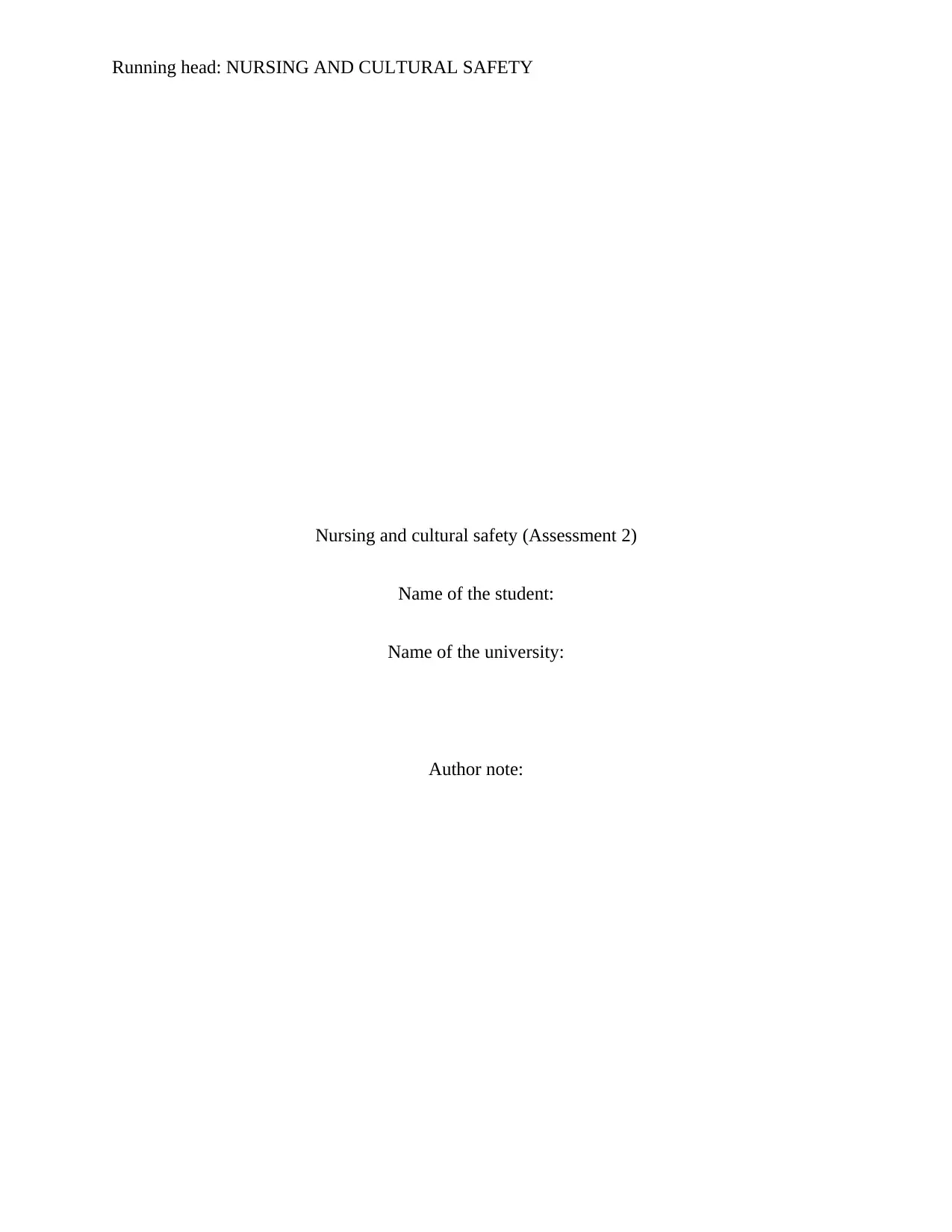
Running head: NURSING AND CULTURAL SAFETY
Nursing and cultural safety (Assessment 2)
Name of the student:
Name of the university:
Author note:
Nursing and cultural safety (Assessment 2)
Name of the student:
Name of the university:
Author note:
Paraphrase This Document
Need a fresh take? Get an instant paraphrase of this document with our AI Paraphraser
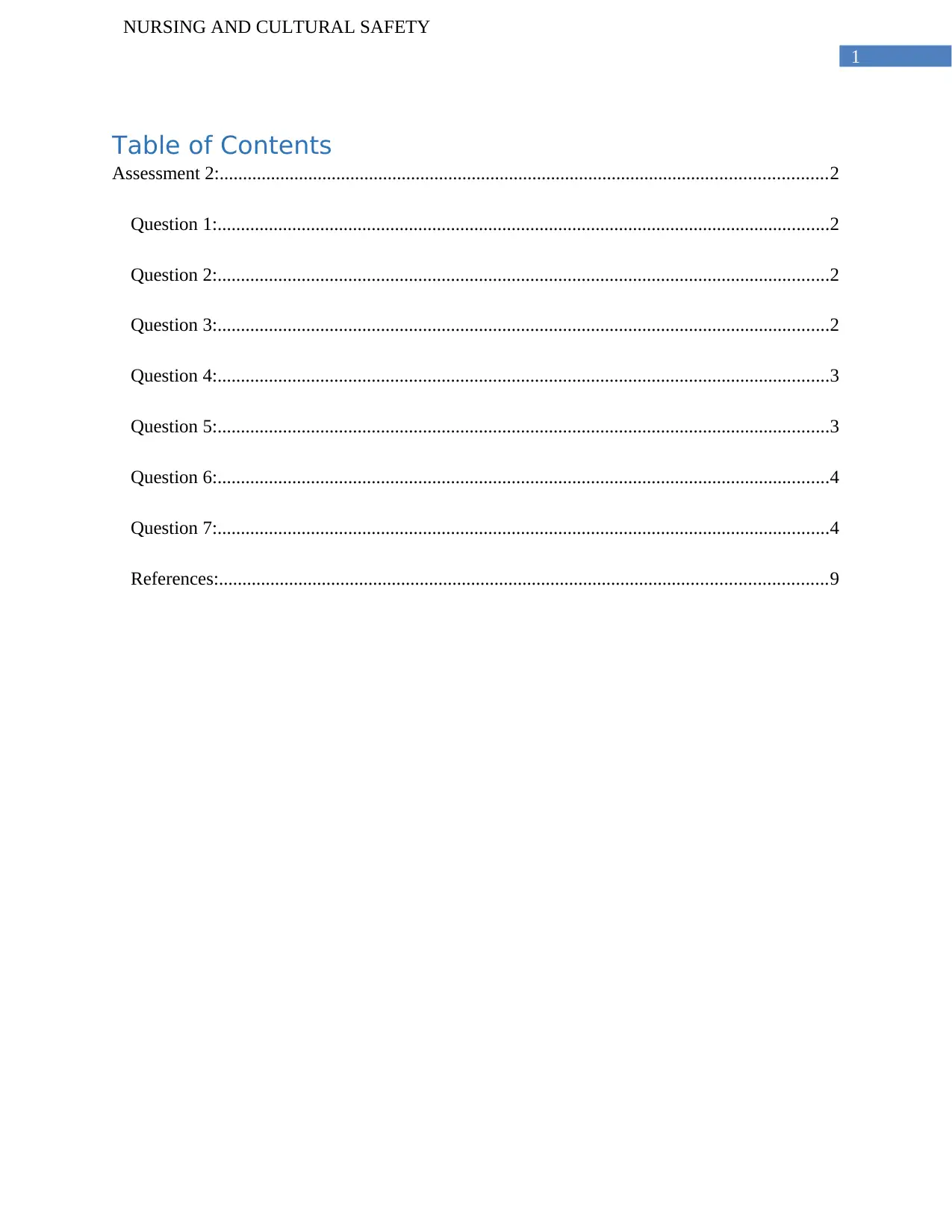
1
NURSING AND CULTURAL SAFETY
Table of Contents
Assessment 2:..................................................................................................................................2
Question 1:...................................................................................................................................2
Question 2:...................................................................................................................................2
Question 3:...................................................................................................................................2
Question 4:...................................................................................................................................3
Question 5:...................................................................................................................................3
Question 6:...................................................................................................................................4
Question 7:...................................................................................................................................4
References:..................................................................................................................................9
NURSING AND CULTURAL SAFETY
Table of Contents
Assessment 2:..................................................................................................................................2
Question 1:...................................................................................................................................2
Question 2:...................................................................................................................................2
Question 3:...................................................................................................................................2
Question 4:...................................................................................................................................3
Question 5:...................................................................................................................................3
Question 6:...................................................................................................................................4
Question 7:...................................................................................................................................4
References:..................................................................................................................................9
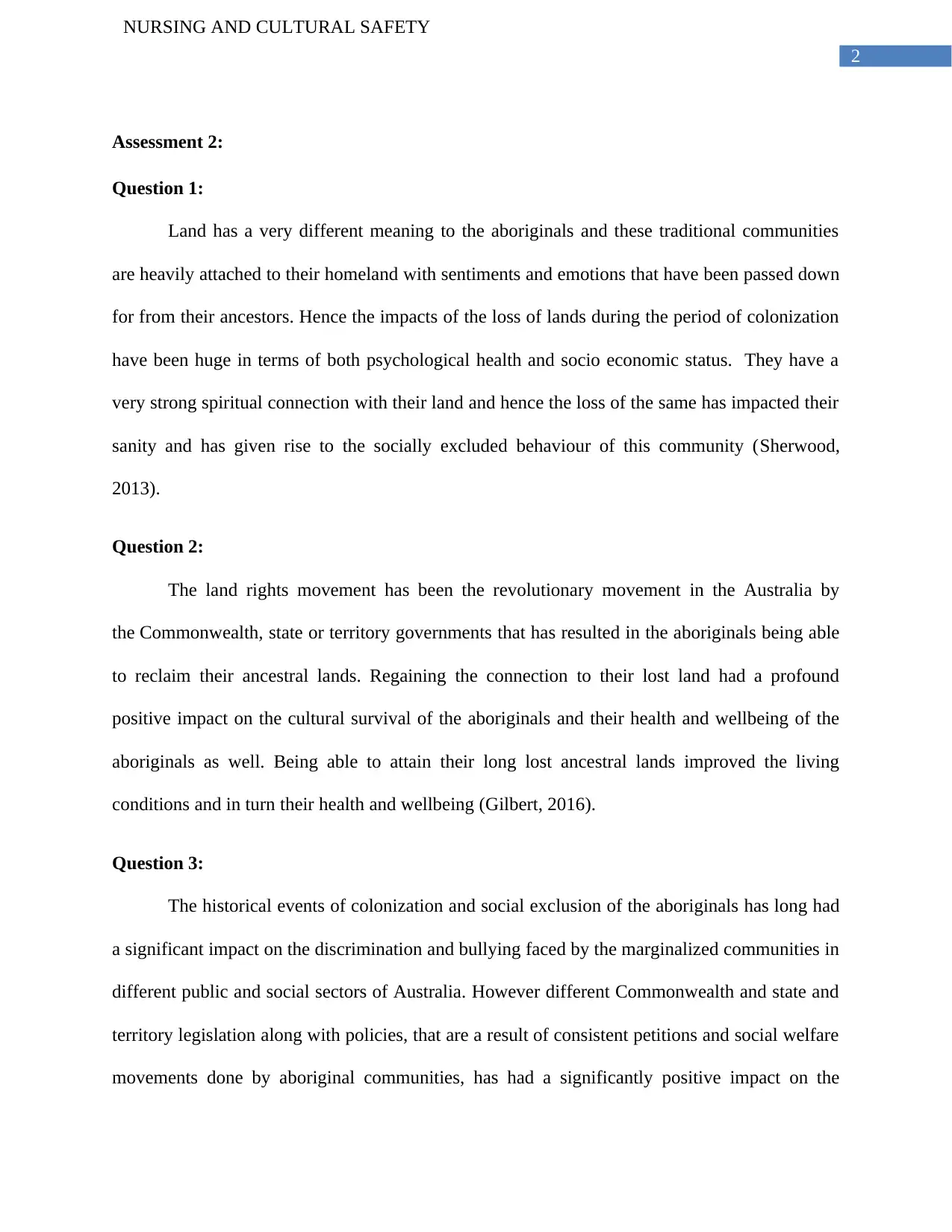
2
NURSING AND CULTURAL SAFETY
Assessment 2:
Question 1:
Land has a very different meaning to the aboriginals and these traditional communities
are heavily attached to their homeland with sentiments and emotions that have been passed down
for from their ancestors. Hence the impacts of the loss of lands during the period of colonization
have been huge in terms of both psychological health and socio economic status. They have a
very strong spiritual connection with their land and hence the loss of the same has impacted their
sanity and has given rise to the socially excluded behaviour of this community (Sherwood,
2013).
Question 2:
The land rights movement has been the revolutionary movement in the Australia by
the Commonwealth, state or territory governments that has resulted in the aboriginals being able
to reclaim their ancestral lands. Regaining the connection to their lost land had a profound
positive impact on the cultural survival of the aboriginals and their health and wellbeing of the
aboriginals as well. Being able to attain their long lost ancestral lands improved the living
conditions and in turn their health and wellbeing (Gilbert, 2016).
Question 3:
The historical events of colonization and social exclusion of the aboriginals has long had
a significant impact on the discrimination and bullying faced by the marginalized communities in
different public and social sectors of Australia. However different Commonwealth and state and
territory legislation along with policies, that are a result of consistent petitions and social welfare
movements done by aboriginal communities, has had a significantly positive impact on the
NURSING AND CULTURAL SAFETY
Assessment 2:
Question 1:
Land has a very different meaning to the aboriginals and these traditional communities
are heavily attached to their homeland with sentiments and emotions that have been passed down
for from their ancestors. Hence the impacts of the loss of lands during the period of colonization
have been huge in terms of both psychological health and socio economic status. They have a
very strong spiritual connection with their land and hence the loss of the same has impacted their
sanity and has given rise to the socially excluded behaviour of this community (Sherwood,
2013).
Question 2:
The land rights movement has been the revolutionary movement in the Australia by
the Commonwealth, state or territory governments that has resulted in the aboriginals being able
to reclaim their ancestral lands. Regaining the connection to their lost land had a profound
positive impact on the cultural survival of the aboriginals and their health and wellbeing of the
aboriginals as well. Being able to attain their long lost ancestral lands improved the living
conditions and in turn their health and wellbeing (Gilbert, 2016).
Question 3:
The historical events of colonization and social exclusion of the aboriginals has long had
a significant impact on the discrimination and bullying faced by the marginalized communities in
different public and social sectors of Australia. However different Commonwealth and state and
territory legislation along with policies, that are a result of consistent petitions and social welfare
movements done by aboriginal communities, has had a significantly positive impact on the
⊘ This is a preview!⊘
Do you want full access?
Subscribe today to unlock all pages.

Trusted by 1+ million students worldwide
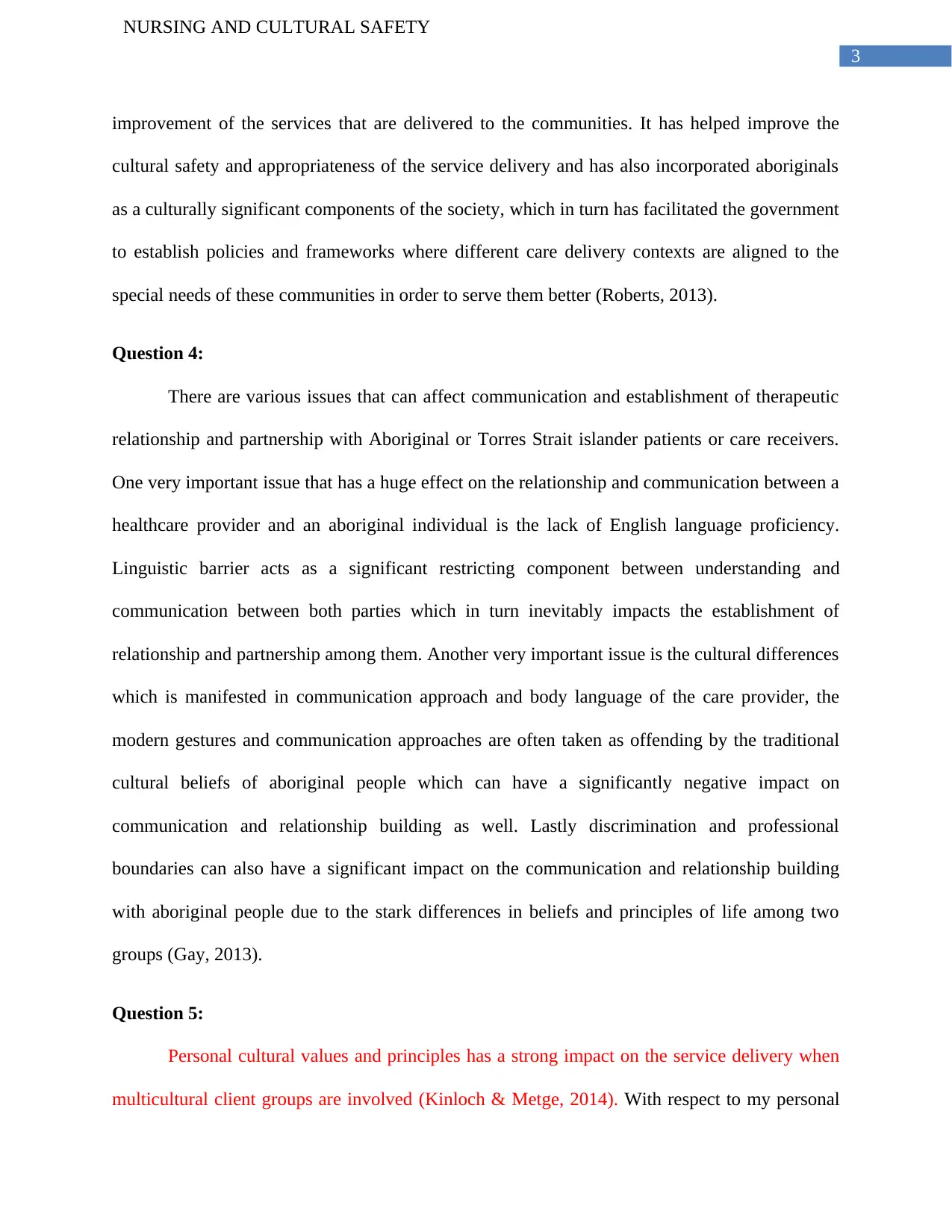
3
NURSING AND CULTURAL SAFETY
improvement of the services that are delivered to the communities. It has helped improve the
cultural safety and appropriateness of the service delivery and has also incorporated aboriginals
as a culturally significant components of the society, which in turn has facilitated the government
to establish policies and frameworks where different care delivery contexts are aligned to the
special needs of these communities in order to serve them better (Roberts, 2013).
Question 4:
There are various issues that can affect communication and establishment of therapeutic
relationship and partnership with Aboriginal or Torres Strait islander patients or care receivers.
One very important issue that has a huge effect on the relationship and communication between a
healthcare provider and an aboriginal individual is the lack of English language proficiency.
Linguistic barrier acts as a significant restricting component between understanding and
communication between both parties which in turn inevitably impacts the establishment of
relationship and partnership among them. Another very important issue is the cultural differences
which is manifested in communication approach and body language of the care provider, the
modern gestures and communication approaches are often taken as offending by the traditional
cultural beliefs of aboriginal people which can have a significantly negative impact on
communication and relationship building as well. Lastly discrimination and professional
boundaries can also have a significant impact on the communication and relationship building
with aboriginal people due to the stark differences in beliefs and principles of life among two
groups (Gay, 2013).
Question 5:
Personal cultural values and principles has a strong impact on the service delivery when
multicultural client groups are involved (Kinloch & Metge, 2014). With respect to my personal
NURSING AND CULTURAL SAFETY
improvement of the services that are delivered to the communities. It has helped improve the
cultural safety and appropriateness of the service delivery and has also incorporated aboriginals
as a culturally significant components of the society, which in turn has facilitated the government
to establish policies and frameworks where different care delivery contexts are aligned to the
special needs of these communities in order to serve them better (Roberts, 2013).
Question 4:
There are various issues that can affect communication and establishment of therapeutic
relationship and partnership with Aboriginal or Torres Strait islander patients or care receivers.
One very important issue that has a huge effect on the relationship and communication between a
healthcare provider and an aboriginal individual is the lack of English language proficiency.
Linguistic barrier acts as a significant restricting component between understanding and
communication between both parties which in turn inevitably impacts the establishment of
relationship and partnership among them. Another very important issue is the cultural differences
which is manifested in communication approach and body language of the care provider, the
modern gestures and communication approaches are often taken as offending by the traditional
cultural beliefs of aboriginal people which can have a significantly negative impact on
communication and relationship building as well. Lastly discrimination and professional
boundaries can also have a significant impact on the communication and relationship building
with aboriginal people due to the stark differences in beliefs and principles of life among two
groups (Gay, 2013).
Question 5:
Personal cultural values and principles has a strong impact on the service delivery when
multicultural client groups are involved (Kinloch & Metge, 2014). With respect to my personal
Paraphrase This Document
Need a fresh take? Get an instant paraphrase of this document with our AI Paraphraser
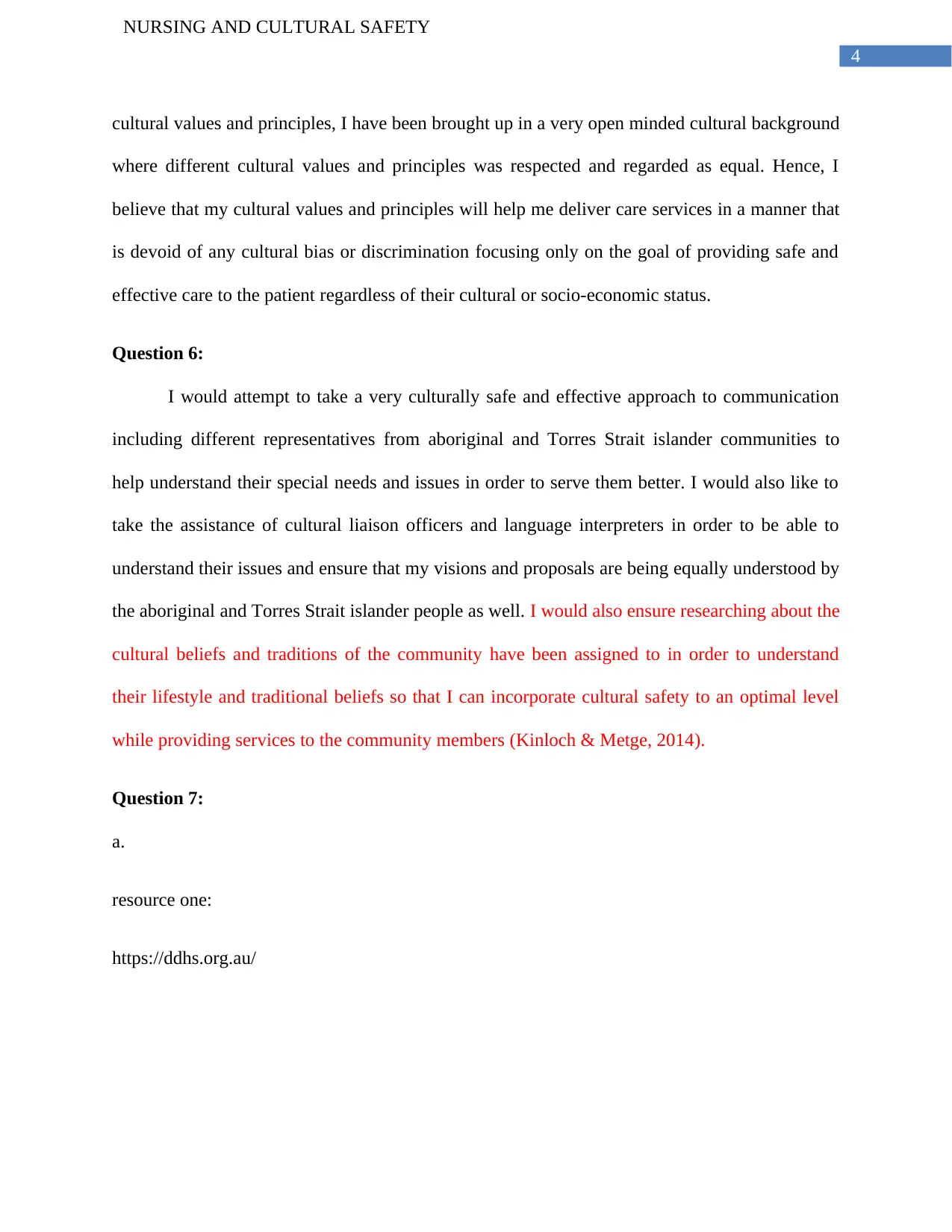
4
NURSING AND CULTURAL SAFETY
cultural values and principles, I have been brought up in a very open minded cultural background
where different cultural values and principles was respected and regarded as equal. Hence, I
believe that my cultural values and principles will help me deliver care services in a manner that
is devoid of any cultural bias or discrimination focusing only on the goal of providing safe and
effective care to the patient regardless of their cultural or socio-economic status.
Question 6:
I would attempt to take a very culturally safe and effective approach to communication
including different representatives from aboriginal and Torres Strait islander communities to
help understand their special needs and issues in order to serve them better. I would also like to
take the assistance of cultural liaison officers and language interpreters in order to be able to
understand their issues and ensure that my visions and proposals are being equally understood by
the aboriginal and Torres Strait islander people as well. I would also ensure researching about the
cultural beliefs and traditions of the community have been assigned to in order to understand
their lifestyle and traditional beliefs so that I can incorporate cultural safety to an optimal level
while providing services to the community members (Kinloch & Metge, 2014).
Question 7:
a.
resource one:
https://ddhs.org.au/
NURSING AND CULTURAL SAFETY
cultural values and principles, I have been brought up in a very open minded cultural background
where different cultural values and principles was respected and regarded as equal. Hence, I
believe that my cultural values and principles will help me deliver care services in a manner that
is devoid of any cultural bias or discrimination focusing only on the goal of providing safe and
effective care to the patient regardless of their cultural or socio-economic status.
Question 6:
I would attempt to take a very culturally safe and effective approach to communication
including different representatives from aboriginal and Torres Strait islander communities to
help understand their special needs and issues in order to serve them better. I would also like to
take the assistance of cultural liaison officers and language interpreters in order to be able to
understand their issues and ensure that my visions and proposals are being equally understood by
the aboriginal and Torres Strait islander people as well. I would also ensure researching about the
cultural beliefs and traditions of the community have been assigned to in order to understand
their lifestyle and traditional beliefs so that I can incorporate cultural safety to an optimal level
while providing services to the community members (Kinloch & Metge, 2014).
Question 7:
a.
resource one:
https://ddhs.org.au/
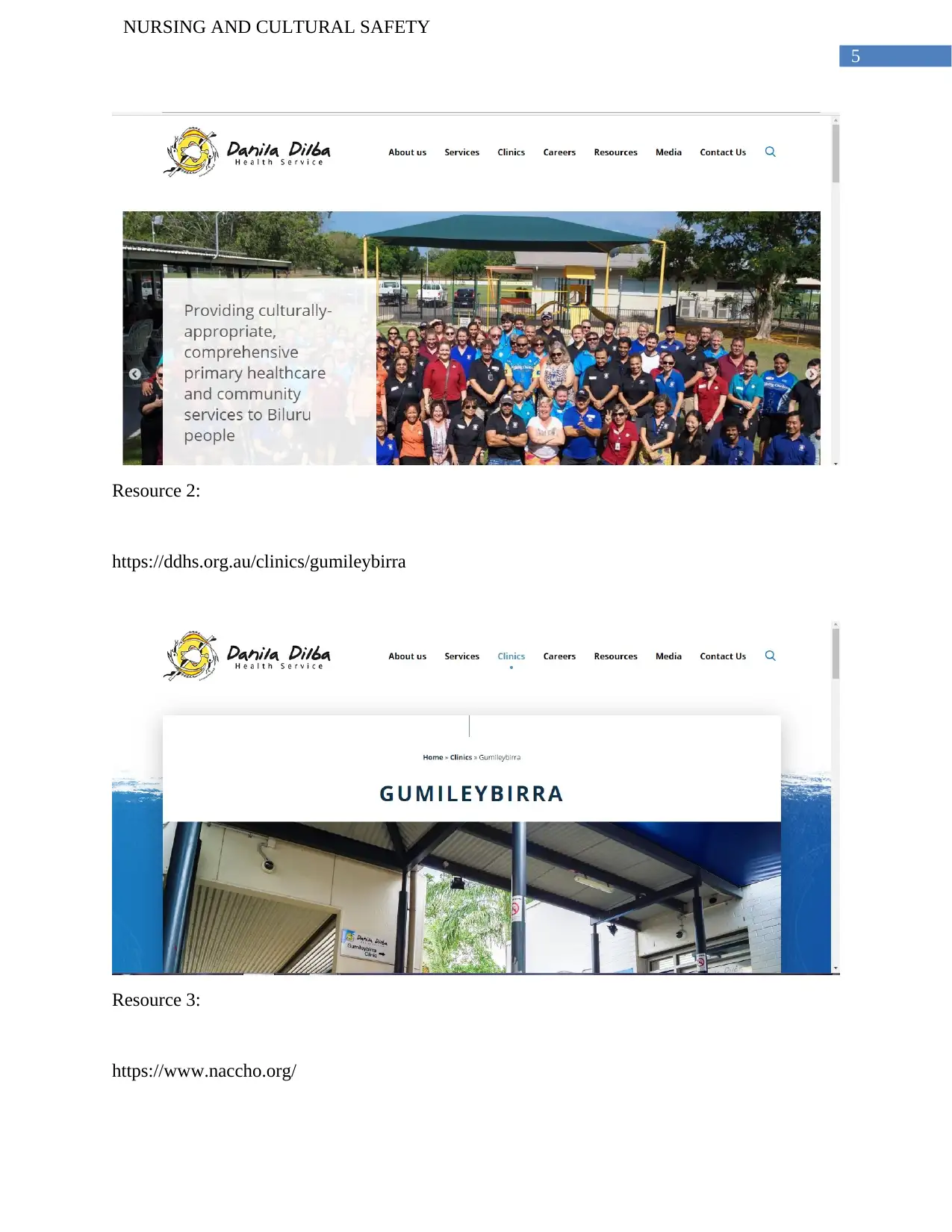
5
NURSING AND CULTURAL SAFETY
Resource 2:
https://ddhs.org.au/clinics/gumileybirra
Resource 3:
https://www.naccho.org/
NURSING AND CULTURAL SAFETY
Resource 2:
https://ddhs.org.au/clinics/gumileybirra
Resource 3:
https://www.naccho.org/
⊘ This is a preview!⊘
Do you want full access?
Subscribe today to unlock all pages.

Trusted by 1+ million students worldwide
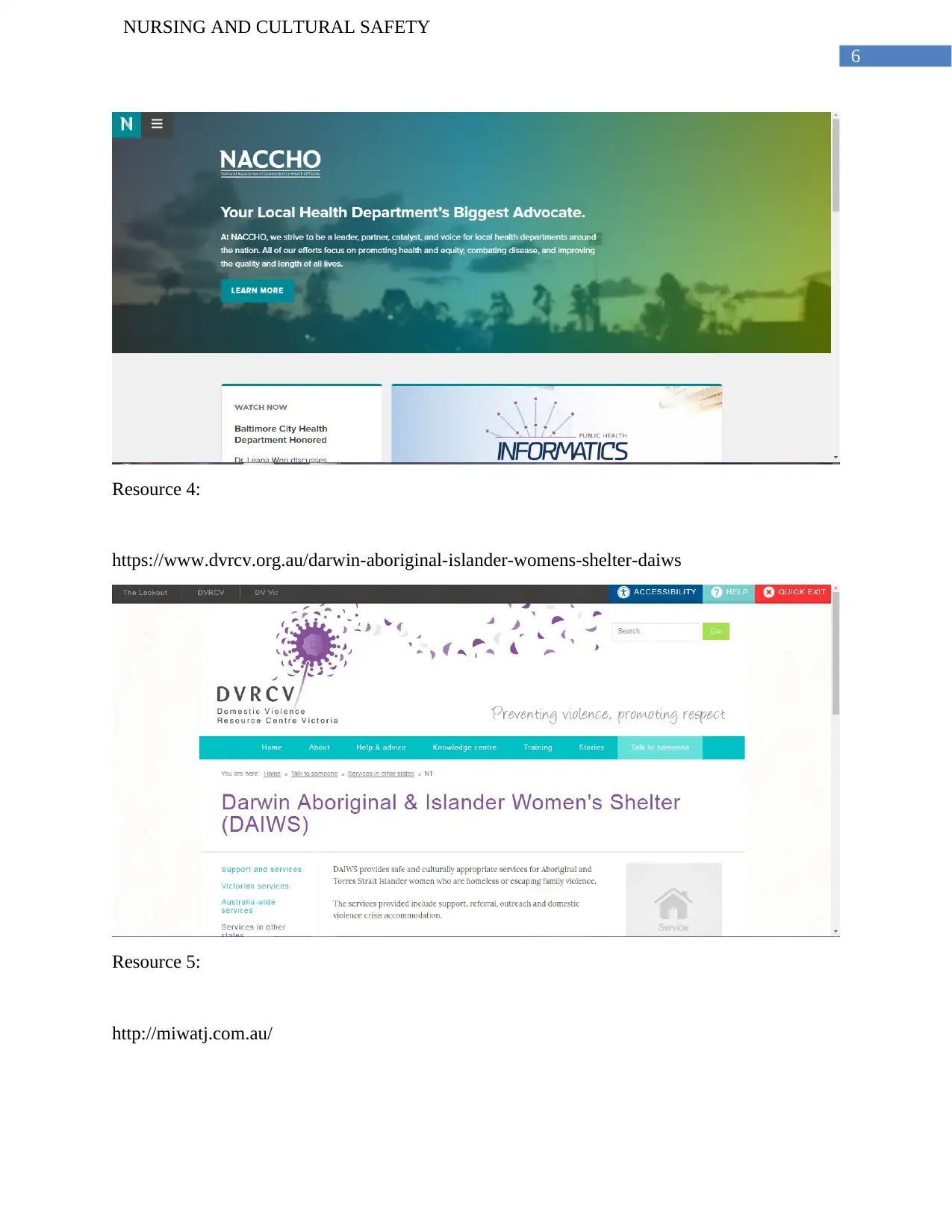
6
NURSING AND CULTURAL SAFETY
Resource 4:
https://www.dvrcv.org.au/darwin-aboriginal-islander-womens-shelter-daiws
Resource 5:
http://miwatj.com.au/
NURSING AND CULTURAL SAFETY
Resource 4:
https://www.dvrcv.org.au/darwin-aboriginal-islander-womens-shelter-daiws
Resource 5:
http://miwatj.com.au/
Paraphrase This Document
Need a fresh take? Get an instant paraphrase of this document with our AI Paraphraser
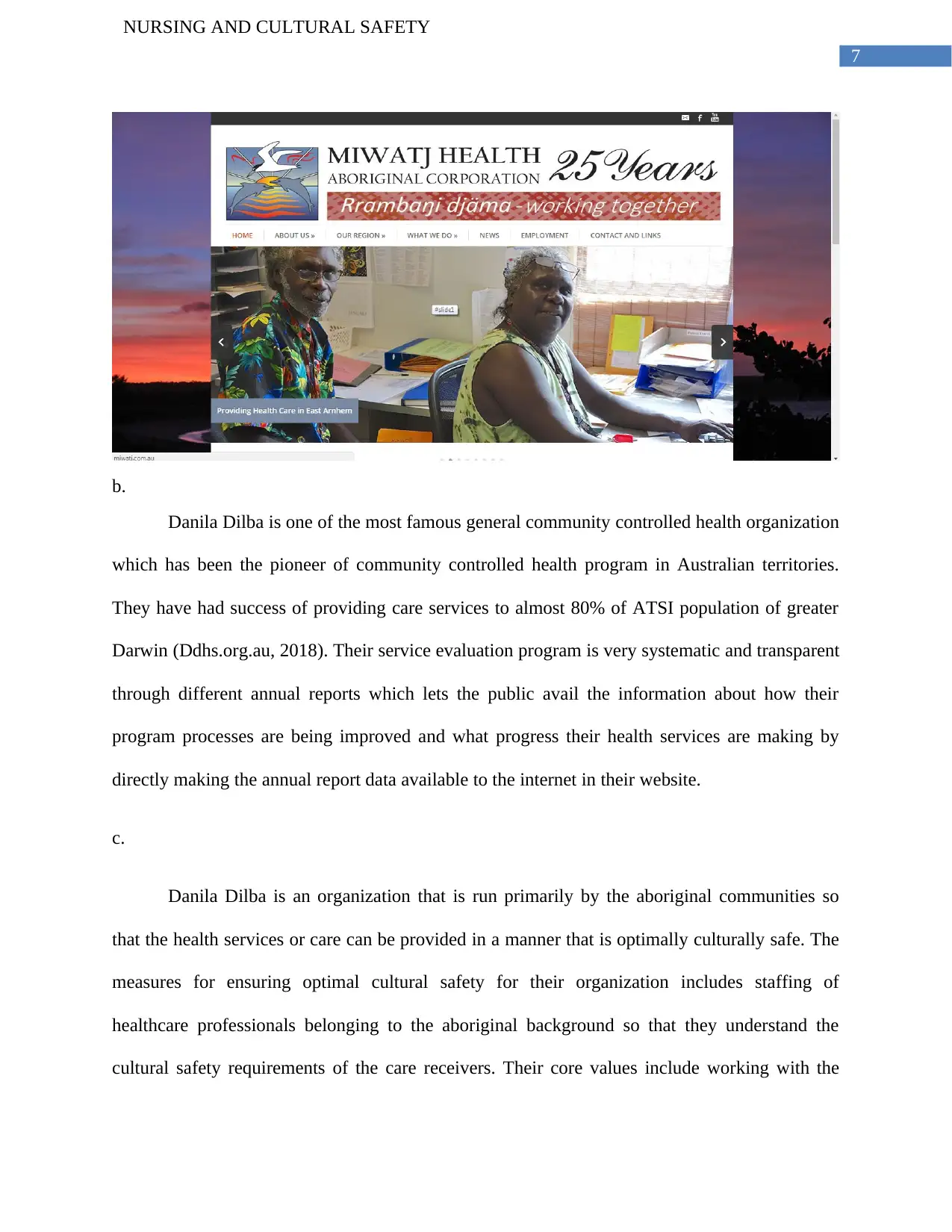
7
NURSING AND CULTURAL SAFETY
b.
Danila Dilba is one of the most famous general community controlled health organization
which has been the pioneer of community controlled health program in Australian territories.
They have had success of providing care services to almost 80% of ATSI population of greater
Darwin (Ddhs.org.au, 2018). Their service evaluation program is very systematic and transparent
through different annual reports which lets the public avail the information about how their
program processes are being improved and what progress their health services are making by
directly making the annual report data available to the internet in their website.
c.
Danila Dilba is an organization that is run primarily by the aboriginal communities so
that the health services or care can be provided in a manner that is optimally culturally safe. The
measures for ensuring optimal cultural safety for their organization includes staffing of
healthcare professionals belonging to the aboriginal background so that they understand the
cultural safety requirements of the care receivers. Their core values include working with the
NURSING AND CULTURAL SAFETY
b.
Danila Dilba is one of the most famous general community controlled health organization
which has been the pioneer of community controlled health program in Australian territories.
They have had success of providing care services to almost 80% of ATSI population of greater
Darwin (Ddhs.org.au, 2018). Their service evaluation program is very systematic and transparent
through different annual reports which lets the public avail the information about how their
program processes are being improved and what progress their health services are making by
directly making the annual report data available to the internet in their website.
c.
Danila Dilba is an organization that is run primarily by the aboriginal communities so
that the health services or care can be provided in a manner that is optimally culturally safe. The
measures for ensuring optimal cultural safety for their organization includes staffing of
healthcare professionals belonging to the aboriginal background so that they understand the
cultural safety requirements of the care receivers. Their core values include working with the
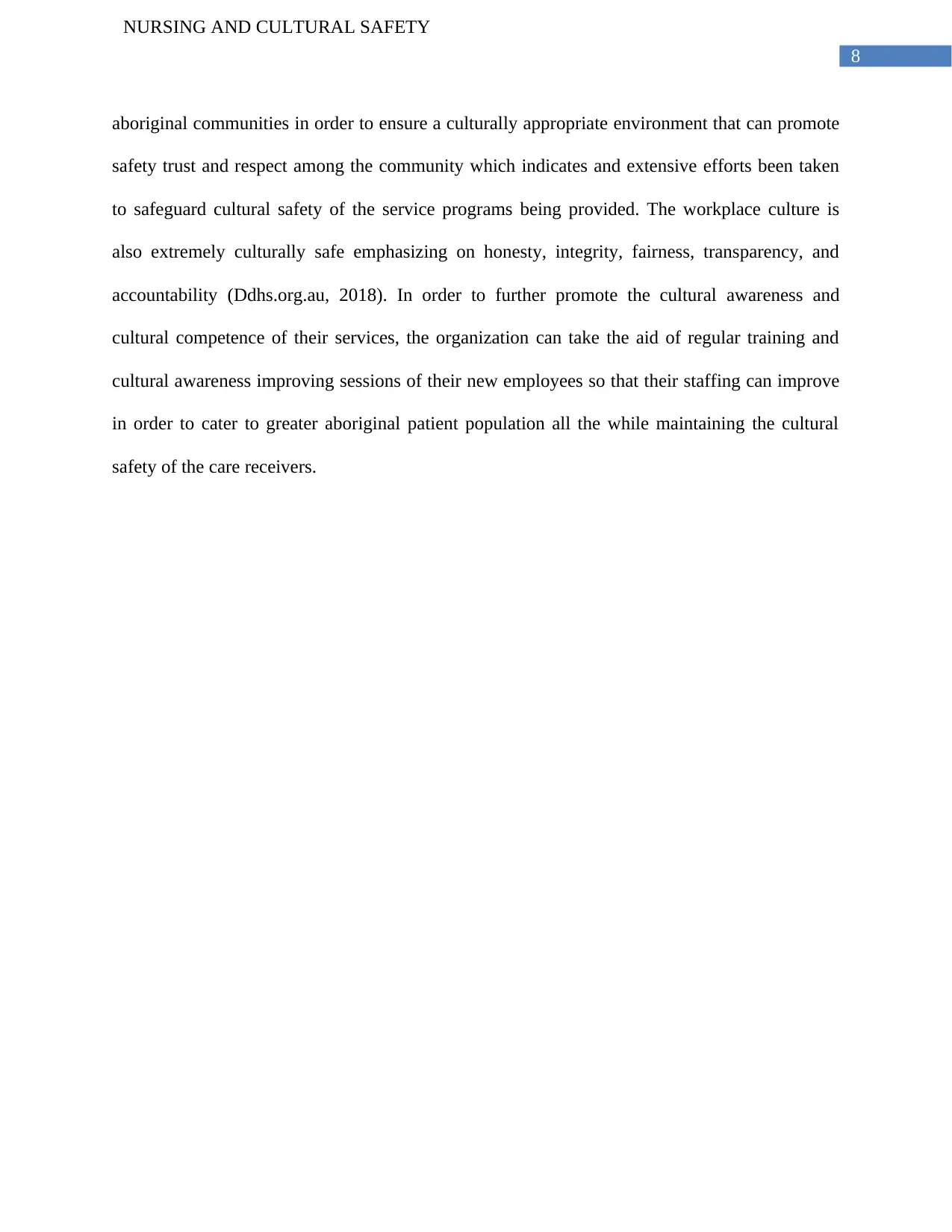
8
NURSING AND CULTURAL SAFETY
aboriginal communities in order to ensure a culturally appropriate environment that can promote
safety trust and respect among the community which indicates and extensive efforts been taken
to safeguard cultural safety of the service programs being provided. The workplace culture is
also extremely culturally safe emphasizing on honesty, integrity, fairness, transparency, and
accountability (Ddhs.org.au, 2018). In order to further promote the cultural awareness and
cultural competence of their services, the organization can take the aid of regular training and
cultural awareness improving sessions of their new employees so that their staffing can improve
in order to cater to greater aboriginal patient population all the while maintaining the cultural
safety of the care receivers.
NURSING AND CULTURAL SAFETY
aboriginal communities in order to ensure a culturally appropriate environment that can promote
safety trust and respect among the community which indicates and extensive efforts been taken
to safeguard cultural safety of the service programs being provided. The workplace culture is
also extremely culturally safe emphasizing on honesty, integrity, fairness, transparency, and
accountability (Ddhs.org.au, 2018). In order to further promote the cultural awareness and
cultural competence of their services, the organization can take the aid of regular training and
cultural awareness improving sessions of their new employees so that their staffing can improve
in order to cater to greater aboriginal patient population all the while maintaining the cultural
safety of the care receivers.
⊘ This is a preview!⊘
Do you want full access?
Subscribe today to unlock all pages.

Trusted by 1+ million students worldwide
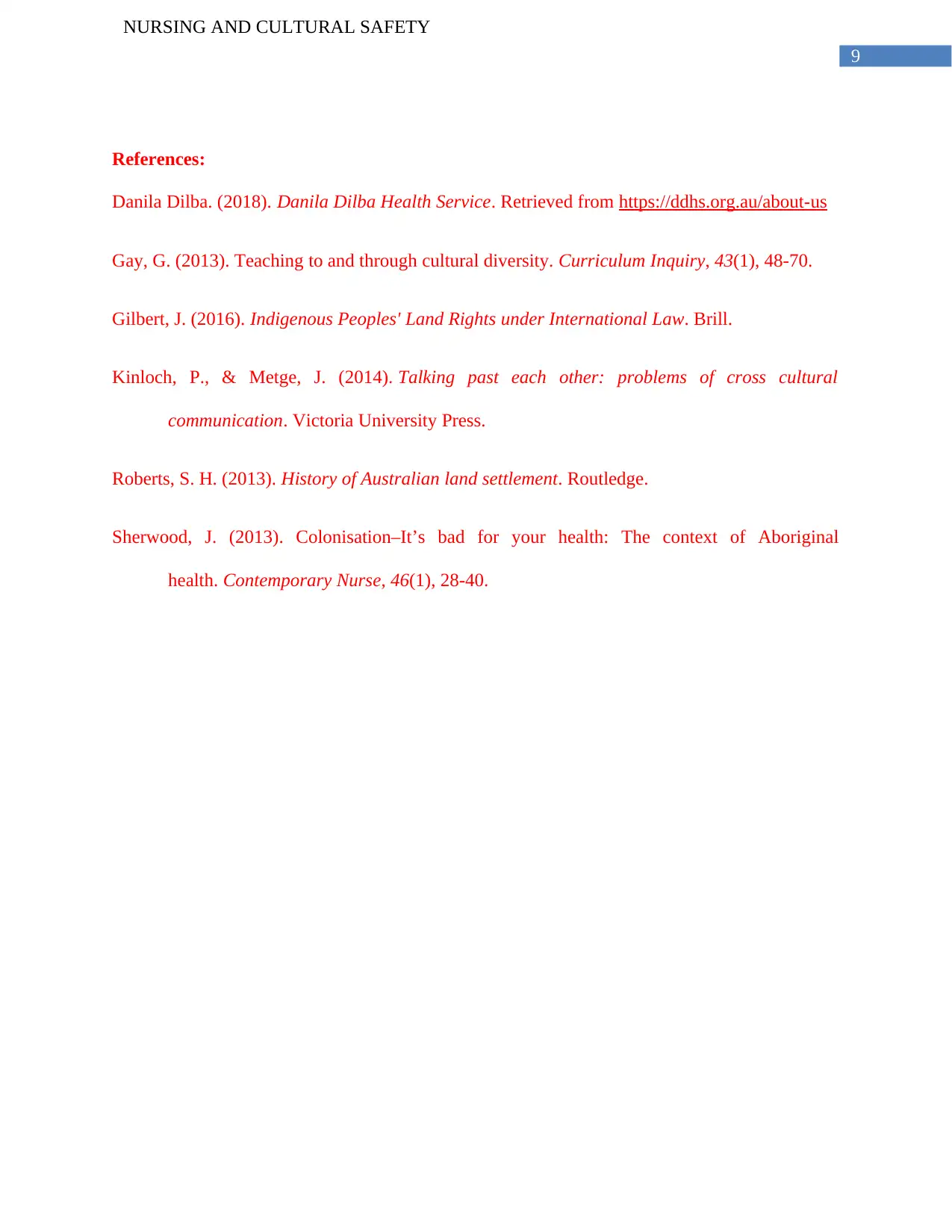
9
NURSING AND CULTURAL SAFETY
References:
Danila Dilba. (2018). Danila Dilba Health Service. Retrieved from https://ddhs.org.au/about-us
Gay, G. (2013). Teaching to and through cultural diversity. Curriculum Inquiry, 43(1), 48-70.
Gilbert, J. (2016). Indigenous Peoples' Land Rights under International Law. Brill.
Kinloch, P., & Metge, J. (2014). Talking past each other: problems of cross cultural
communication. Victoria University Press.
Roberts, S. H. (2013). History of Australian land settlement. Routledge.
Sherwood, J. (2013). Colonisation–It’s bad for your health: The context of Aboriginal
health. Contemporary Nurse, 46(1), 28-40.
NURSING AND CULTURAL SAFETY
References:
Danila Dilba. (2018). Danila Dilba Health Service. Retrieved from https://ddhs.org.au/about-us
Gay, G. (2013). Teaching to and through cultural diversity. Curriculum Inquiry, 43(1), 48-70.
Gilbert, J. (2016). Indigenous Peoples' Land Rights under International Law. Brill.
Kinloch, P., & Metge, J. (2014). Talking past each other: problems of cross cultural
communication. Victoria University Press.
Roberts, S. H. (2013). History of Australian land settlement. Routledge.
Sherwood, J. (2013). Colonisation–It’s bad for your health: The context of Aboriginal
health. Contemporary Nurse, 46(1), 28-40.
1 out of 10
Related Documents
Your All-in-One AI-Powered Toolkit for Academic Success.
+13062052269
info@desklib.com
Available 24*7 on WhatsApp / Email
![[object Object]](/_next/static/media/star-bottom.7253800d.svg)
Unlock your academic potential
Copyright © 2020–2025 A2Z Services. All Rights Reserved. Developed and managed by ZUCOL.





